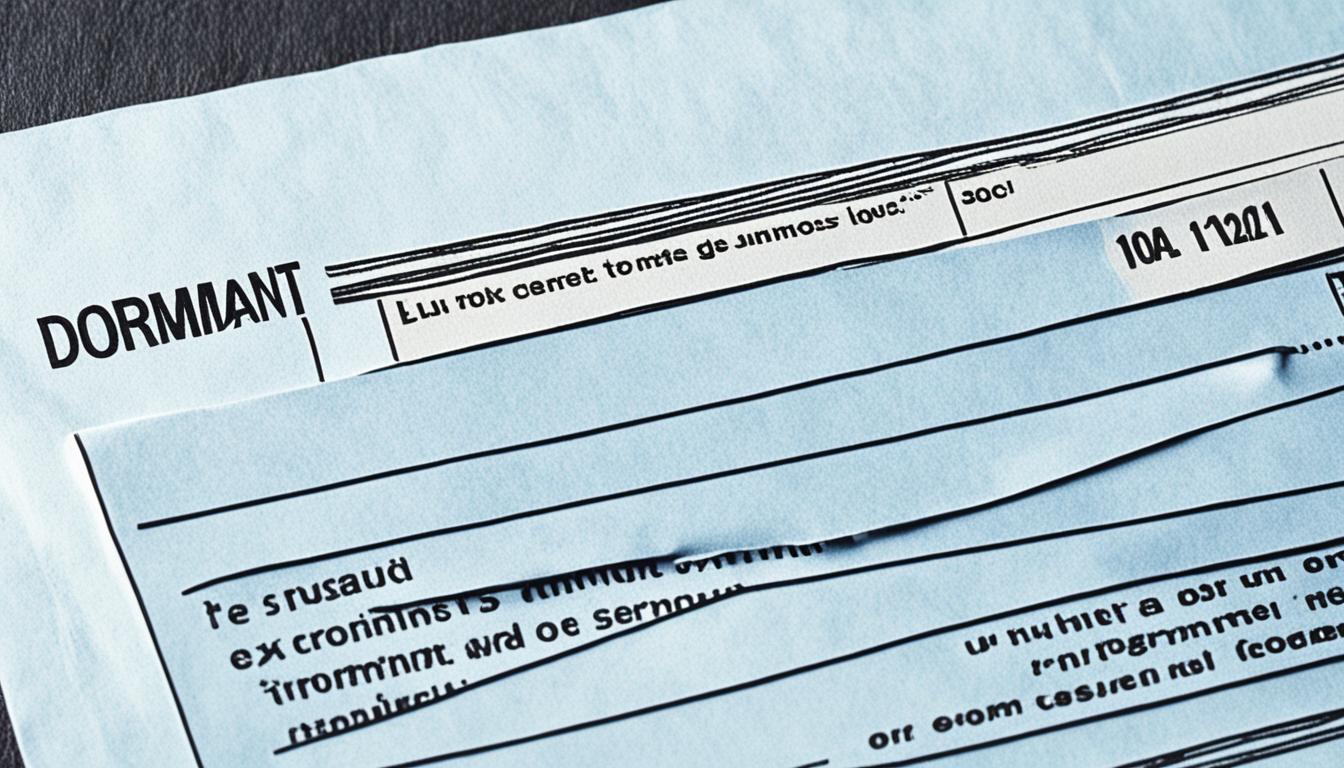Are you wondering how to notify HMRC that your company is dormant? If your company is not trading and has no income, it’s important to inform HMRC of its dormant status. This will save you from unnecessary tax-related headaches and ensure compliance with Corporation Tax regulations.
Fortunately, telling HMRC that your company is dormant is a straightforward process. You can easily use the online service provided by HMRC to inform them that your company is not trading and is dormant for Corporation Tax purposes. Once you’ve notified HMRC, you won’t have to file another Company Tax Return unless either HMRC asks you to or you begin trading again. It’s that simple!
Agents can also use the online service on behalf of their clients, making it even more convenient. However, if you prefer, you can also notify HMRC of your company’s dormant status over the phone or by post. HMRC provides multiple options to suit your preference.
So, whether you choose to use the online service or opt for the traditional methods, make sure to inform HMRC promptly about your company’s dormant status. By doing so, you can stay compliant and avoid unnecessary tax filings until you decide to start trading again.
When Does a Company Become Dormant?
A company becomes dormant when it stops trading and has no other income. This includes new limited companies that haven’t started trading, unincorporated associations or clubs that owe less than £100 in Corporation Tax, and flat management companies. If the company has filed a Company Tax Return before becoming dormant, it will still need to file one online to show HMRC that it is dormant for that period. Once a limited company informs HMRC of its dormant status, it will not need to pay Corporation Tax or file another Company Tax Return.
Informing HMRC of a company’s dormant status is an important step to comply with tax regulations. It ensures that the company is not subject to unnecessary tax obligations when it is not actively trading. This can provide administrative and financial benefits to the company during periods of inactivity. Companies should notify HMRC promptly to avoid any penalties or misunderstandings regarding their status.
Being recognized as a dormant company by HMRC exempts businesses from the requirement to pay Corporation Tax or file a Company Tax Return. It is important to note that if a company has already filed a Company Tax Return before becoming dormant, it will still need to file one online to show HMRC that it is dormant for that specific period.
How to Notify HMRC that Your Company is Dormant?
To notify HMRC that your company is dormant, you have several options available. The most convenient method is by using the online service provided, which allows you to submit the necessary information quickly and efficiently.
To begin the process, you will need to provide your company’s name and 10-digit Unique Taxpayer Reference (UTR). If you are unsure of your UTR, you can easily find it using the provided link on the HMRC website. Additionally, you will be asked to provide the date on which your company ceased trading, if applicable. The online service ensures a straightforward and streamlined process, allowing you to notify HMRC of your dormant status with ease.

If for any reason you are unable to utilize the online service, alternative methods are also available. You can notify HMRC by phone, providing the necessary details over a conversation. Alternatively, you can choose to notify HMRC by post, mailing the required information to the appropriate address.
Regardless of the method you choose, it is vital to ensure that you inform HMRC promptly of your company’s dormant status. By doing so, you can fulfill your obligations and avoid unnecessary communication or penalties related to Corporation Tax.
Responsibilities After Notifying HMRC of Dormant Status
Once you have notified HMRC of your company’s dormant status, there are certain responsibilities you must fulfill to ensure compliance with the regulations. These responsibilities include:
- Filing Annual Accounts: You are required to submit annual accounts to Companies House, providing a detailed overview of your company’s financial activities during its dormant period. This helps maintain transparency and accountability.
- Confirmation Statement: Alongside the annual accounts, you should also file a confirmation statement with Companies House. This document confirms that your company’s details, such as shareholders, registered address, and directors, are accurate and up to date.
- VAT Deregistration: If your company is registered for VAT and does not plan to resume trading, it is crucial to deregister for VAT within 30 days of becoming dormant. This ensures that you are not liable for VAT obligations.
- Nil VAT Returns: However, if you intend to restart trading in the future, you must continue submitting “nil” (empty) VAT returns while your company remains dormant. This keeps your VAT record active and prevents any potential penalties.
- Closing PAYE Scheme: If your dormant company employs people and you do not plan to resume trading in the current tax year, it is advisable to close your PAYE (Pay As You Earn) scheme. This action notifies HMRC that you no longer have any active employees.
Remember, fulfilling these responsibilities ensures that you meet the legal requirements of a dormant company and helps maintain accurate records with both HMRC and Companies House.
Illustrative Example
To provide a clearer understanding of the responsibilities after notifying HMRC of a dormant company status, refer to the table below:
| Responsibility | Description |
|---|---|
| Filing Annual Accounts | Submission of comprehensive financial statements detailing the dormant company’s financial activities during the reporting period. |
| Confirmation Statement | An official document confirming the company’s up-to-date information, including details of shareholders, registered address, and directors. |
| VAT Deregistration | Deregistering the dormant company for VAT obligations if trading is not expected to resume. |
| Nil VAT Returns | Submission of empty VAT returns to maintain an active VAT record during the company’s dormant phase. |
| Closing PAYE Scheme | Informing HMRC of the closure of the Pay As You Earn (PAYE) scheme if there are no active employees during the dormant period. |

Procedure for Notifying HMRC before Company Starts Running
If your company has not yet started running and has no income or expenses to report, you should inform HMRC of its dormant status. This can be done by completing and submitting a form CT41G, which is a “Company Tax Return – Notice to deliver.” The form notifies HMRC that your company is not yet active and does not have any tax obligations at the moment. You may need to provide basic information about your company, such as its name, registration number, and address.
Informing HMRC about your business’s inactivity is a crucial step to comply with the necessary tax regulations. By submitting the form CT41G, you notify HMRC that your company is not currently operational and therefore exempt from any tax obligations. This allows HMRC to maintain accurate records and avoid unnecessary communications regarding tax returns and payments.
The CT41G form requires basic details about your company to ensure a streamlined process. This includes providing your company’s name, registration number, and address. By submitting this form, HMRC will be aware of the status of your business and can update their records accordingly.
Submitting the CT41G form is a simple and efficient way to inform HMRC about your company’s inactive status. By proactively notifying HMRC before your company starts running, you can avoid any potential confusion or misunderstandings regarding your tax obligations. It is important to comply with HMRC requirements and keep them updated on your business’s status to ensure a smooth and compliant tax process.
Restarting a Dormant Company
So, you’ve made the decision to bring your dormant company back to life and start trading again. It’s an exciting time, but it’s important to ensure that you follow the necessary procedures to inform HMRC and Companies House, as well as fulfill your reporting requirements. Here’s a step-by-step guide on how to restart a dormant company:
1. Inform HMRC and file tax returns
When you decide to restart your dormant company and begin trading, you must inform HMRC of the change in your business status. You can do this by using the online services provided by HMRC. Additionally, you must file the necessary tax returns and make any required tax payments. This ensures that your company remains compliant with HMRC regulations and avoids any penalties or fines.
2. Update your status with Companies House
Updating your company’s status with Companies House is another crucial step in restarting your dormant company. You will need to submit the necessary documentation and information to reflect the changes in your company’s activities. This may include updating your company’s annual accounts and filing a confirmation statement. By keeping your company’s information up to date, you maintain transparency and compliance with Companies House regulations.
3. Fulfill reporting obligations
Restarting your company also means fulfilling reporting obligations that may be required by HMRC and Companies House. This includes providing any necessary financial statements, tax returns, and other relevant documents. By meeting these obligations, you ensure that your company’s financial affairs are accurately reported and comply with the relevant authorities’ requirements.
Remember, it is crucial to follow the appropriate procedures to ensure compliance with HMRC and Companies House requirements when restarting a dormant company.
4. Seek professional advice if needed
If you’re unsure about the specific steps and requirements for restarting your dormant company, it’s recommended to seek professional advice. An accountant or business advisor with experience in company restarts can provide invaluable guidance and ensure that you navigate the process smoothly.
| Steps to Restart a Dormant Company | Notes |
|---|---|
| Inform HMRC and file tax returns | Use HMRC’s online services to inform them of the change and file the necessary tax returns. |
| Update your status with Companies House | Submit the required documentation and information to reflect the changes in your company’s activities. |
| Fulfill reporting obligations | Provide financial statements, tax returns, and other relevant documents to meet reporting requirements. |
| Seek professional advice if needed | Consult an accountant or business advisor to ensure a smooth restart process. |
Conclusion
Informing HMRC about the dormant status of your company is crucial for maintaining compliance with Corporation Tax regulations. By following the correct procedures and communicating with HMRC through the available channels, you can effectively avoid unnecessary tax-related communications and penalties. It is important to fulfill your responsibilities with Companies House and keep your company’s information updated when necessary.
Remember, notifying HMRC about your dormant company is a straightforward process that can be done online, by phone, or by post. Ensure that you provide accurate and up-to-date information, including your company’s name and Unique Taxpayer Reference (UTR). Once you have successfully informed HMRC, you will not be required to file another Company Tax Return unless specifically asked to do so or if your company commences trading again.
Stay compliant, keep your administrative obligations in order, and enjoy the benefits of a dormant company. If you have any further questions or require assistance, HMRC and Companies House are there to help you navigate the process.




